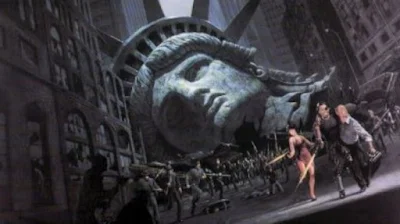
Since at least Planet of the Apes, the Statue of Liberty has been a staple of post-apocalyptic fiction. It's now a de rigeur cliche to include her, in all her battered copper glory.
According to the People's Oracle, otherwise known as Wikipedia, the statue represents the Roman goddess Libertas and holds a tabula ansata, upon which is inscribed the date of the American Declaration of Independence.
From heel to top of her head is 111 feet. If you include the raised arm, she reaches a staggering 151 feet and one inch and weighs in at 450,000 pounds.
 That's 53 feet higher than the Colossus of Rhodes (98 feet), and 48 feet higher than the Colossus of Nero (103 feet). Still dwarfed by the largest statue in the world, The Spring Temple Buddha in China, which is a staggering 420 feet high.
That's 53 feet higher than the Colossus of Rhodes (98 feet), and 48 feet higher than the Colossus of Nero (103 feet). Still dwarfed by the largest statue in the world, The Spring Temple Buddha in China, which is a staggering 420 feet high.But no one bothers blowing it up onscreen.
That honour belongs to Lady Liberty, and she's been at it long enough she should have her own IMDB page.
She's been dismembered by giant monsters, blown to bits by aliens, tossed about like a plaything by super villains, frozen, buried in the desert, submerged beneath the ocean, and otherwise ill treated.
For my money, Planet of the Apes is her finest performance. So stoic. After that, perhaps Cloverfield (the rolling bowling ball head was an unexpected, gutsy choice), then A.I. (she held back here, giving an understated performance that only included her raised torch. Classy.), Deep Impact, and then perhaps Independence Day. She's been in a number of exploitation and knock-off films as well, but we won't talk about those.
You can see some post-apocalypse Lady Liberty below, culled from book, film and concept art.
 |
| She does lose her head frequently. |
 |
| Looks like she lent her arm out to A.I. at this time. |
 |
| There it is. |
 |
| It does get around. |
 |
| A collection of Lady Liberty's appearances. |



















